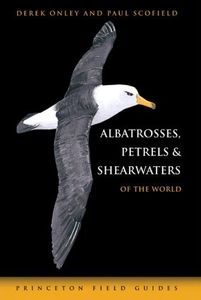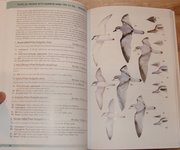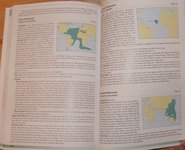Reviewed by Grant McCreary on May 15th, 2007.
Unfortunately, I don’t have a great deal of experience with this group of birds. I’ve only been on two pelagic trips – one out of Westport, Washington and the other from Georgia’s Tybee Island. Therefore, I don’t consider myself qualified to accurately judge the contents of this book. But I can describe its features and hopefully help you determine if it is a worthwhile purchase for you.
The introduction starts off with an overview of taxonomy and concepts of species. This is particularly relevant to this group of birds, as the taxonomy seems to be far from settled. The authors generally follow the taxonomy set forth by Brooke in Albatrosses and Petrels across the World, with some modifications to the smaller shearwaters as suggested by Austin. The main portion of the introduction starts with an overview of the four families – albatrosses, storm-petrels, diving-petrels, and petrels and shearwaters. The latter is broken down into fulmarine petrels, prions, gadfly petrels, and shearwaters. Group characteristics and taxonomic relationships are focused on. This is a very helpful section for those like me that are not very familiar with these birds.
General identification tips are given next, with emphasis on photographs, conditions at sea, size, plumage, and molt. There is also a nice section on conservation. It goes into detail on the many threats these birds face. And finally the introduction concludes with the obligatory “How to use this book” section and a plate of drawings to illustrate seabird topography.
The 45 plates have the illustrations on the right-hand page and text on the facing page. There are 2-8 species per plate, with most having 3-5. The birds are shown in flight from both above and below. For some similar species detailed illustrations of the heads are shown for comparison. The artwork is nice, and seems very serviceable. There are a few issues, though. The backgrounds are mostly solid white and the white albatrosses get lost in it, especially the close-ups of the heads. The main issue I have, however, is with the illustrations that are NOT there. Only three species are shown on the water. For a guide that is “comprehensive” this is inexcusable. Granted, most birders will see these birds in flight, but there are certainly exceptions. On the pelagic trip I was on out of Georgia the only Manx Shearwaters seen were on the water. The only views we got of them in flight would have been insufficient for identification. The illustrations of shearwaters on the water in the Sibley guide made the identification possible. Of course, I don’t have enough experience to tell if this is the exception or the rule.
The text opposite the plates is focused exclusively on identification. There is a description of each species pointing out the relevant field marks. Each illustration is also briefly described. Each species’ header also includes the wingspan and length of the bird in centimeters.
The second half of the book consists of the species accounts. Each account includes:
- Other Names – other English names that are in use
- Taxonomy – describes any subspecies and any sort of taxonomic uncertainty concerning the species
- Distribution
- Behavior – includes flight style, foraging, and social behavior and whether they follow ships
- Jizz – general impression of the size and shape
- Size – total length, wing (using the least chord meathod), wing span, and weight
- Plumage
- Molt and Wear – including timing
- Identification
- Map – includes breeding colonies and range at sea
There are also several sidebars such as “Separation of Short-tailed and Sooty Shearwaters”. These include text and/or charts that compare the given species.
This group of birds presents some difficult ID problems, and therefore any helpful resource is very welcome. I know that I will be studying this guide before any future boat trips. In addition, it seems that these birds are prone to vagrancy and that the distribution for some is still a work in progress. Thus it is extremely helpful to have a current, comprehensive guide to the entire group. Pelagic warriors will undoubtedly want a copy of this guide. But for those who only go on an occasional pelagic trip it is a more difficult decision. If you will be taking a trip through a region where the local field guide covers these birds adequately, then you can probably do without this specialized guide. North American birders, for instance, should be able to get by with just the Sibley Guide 99% of the time. But if the regional field guide isn’t sufficient, or if you want to be prepared for anything, then this guide is recommended.
Disclosure: I get a small commission for purchases made through links in this post.







The authority of the authors rings out from this book. Many of the species are highly confusable. You stand the best chance of distinguishing them with this excellent and well illustrated book. Conservation issues, distributions, threats etc are also lucidly explained making it useful reading even if you aren’t lucky enough to go birding out in the oceans. Go ahead, splash out!